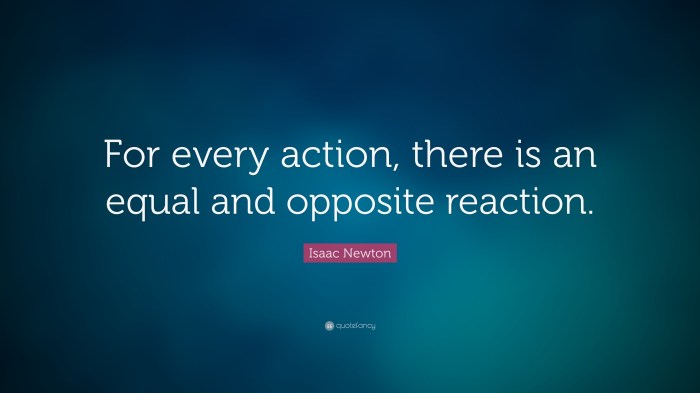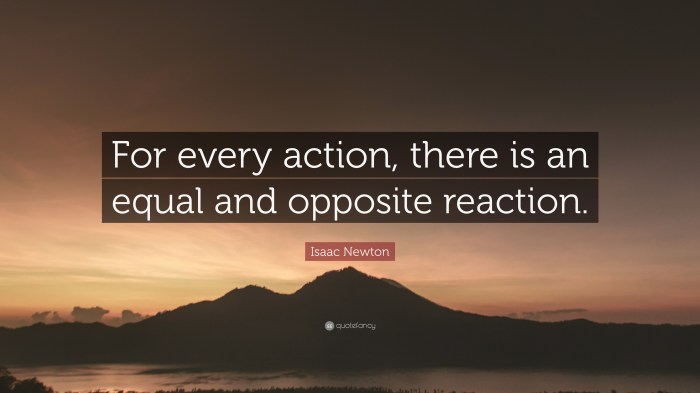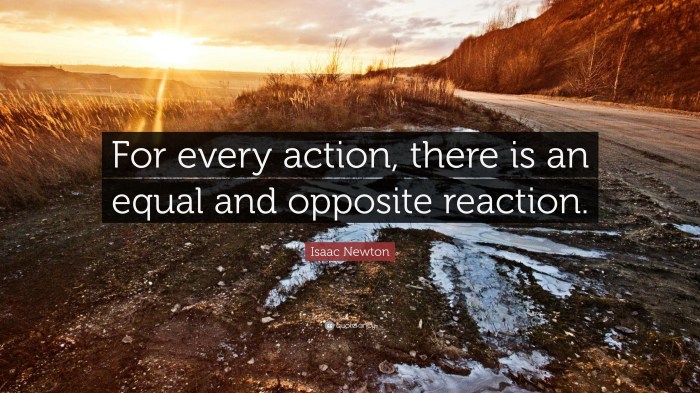
What is the 3rd law of motion? It’s a fundamental principle in physics that governs the interaction between objects. Imagine a rocket blasting off into space, or a swimmer pushing off the wall of a pool. These seemingly simple actions are all governed by the third law, which states that for every action, there is an equal and opposite reaction.
This principle, formulated by Sir Isaac Newton, is a cornerstone of classical mechanics. It explains why objects move, how forces interact, and even how we can propel ourselves through the air or water. We’ll delve deeper into this law, exploring its implications and applications in everyday life and beyond.
Introduction to Newton’s Laws of Motion

Newton’s Laws of Motion are fundamental principles in physics that describe the relationship between an object’s motion and the forces acting upon it. They form the foundation of classical mechanics and are essential for understanding the motion of objects in our everyday world.
Historical Context of Newton’s Laws of Motion, What is the 3rd law of motion
Newton’s Laws of Motion were formulated by Sir Isaac Newton in the late 17th century, building upon the work of earlier scientists like Galileo Galilei. Newton’s groundbreaking work, *Philosophiæ Naturalis Principia Mathematica* (Mathematical Principles of Natural Philosophy), published in 1687, revolutionized our understanding of motion and gravity.
Overview of the First Two Laws of Motion
Newton’s Laws of Motion consist of three fundamental principles:
* Newton’s First Law of Motion (Law of Inertia): An object at rest will remain at rest, and an object in motion will remain in motion at a constant velocity, unless acted upon by an unbalanced force. This law describes the tendency of objects to resist changes in their motion. For example, a book on a table will remain stationary unless pushed or pulled.
* Newton’s Second Law of Motion: The acceleration of an object is directly proportional to the net force acting on it and inversely proportional to its mass. This law quantifies the relationship between force, mass, and acceleration. For example, a heavier object requires a greater force to achieve the same acceleration as a lighter object.
Statement of Newton’s Third Law of Motion

Newton’s Third Law of Motion, often referred to as the “law of action and reaction,” is a fundamental principle that governs the interaction of forces between objects. It states that for every action, there is an equal and opposite reaction.
Meaning of “For Every Action, There Is an Equal and Opposite Reaction”
This statement implies that forces always occur in pairs. When one object exerts a force on another object (the action), the second object simultaneously exerts an equal and opposite force back on the first object (the reaction). These forces are always equal in magnitude but opposite in direction.
Examples of Newton’s Third Law in Action
The Third Law of Motion is evident in various everyday scenarios:
* Walking: When you walk, your feet push backward on the ground (action). In response, the ground pushes forward on your feet (reaction), propelling you forward.
* Swimming: As you push water backward with your arms and legs (action), the water pushes you forward (reaction).
* Rocket Launch: A rocket engine expels hot gases downward (action), and the gases exert an upward force on the rocket (reaction), causing it to launch into space.
* Jumping: When you jump, you push down on the ground (action). The ground pushes back up on you with an equal and opposite force (reaction), launching you into the air.
* Collisions: When two objects collide, they exert equal and opposite forces on each other. For example, if a car crashes into a wall, the car exerts a force on the wall, and the wall exerts an equal and opposite force on the car.
Examples and Illustrations: What Is The 3rd Law Of Motion
The concept of action-reaction pairs can be observed in numerous everyday situations. These examples help to solidify our understanding of how the third law manifests in the world around us.
Examples of Action-Reaction Pairs
Here are some examples of action-reaction pairs in various scenarios:
- Walking: When you walk, your foot pushes backward on the ground (action). In response, the ground pushes forward on your foot (reaction), propelling you forward.
- Swimming: A swimmer pushes water backward with their arms and legs (action). The water, in turn, pushes the swimmer forward (reaction).
- Rowing a Boat: A rower pushes the oars backward against the water (action). The water, in response, pushes the oars and the boat forward (reaction).
- Launching a Rocket: A rocket engine expels hot gases downward (action). The gases, in turn, push upward on the rocket (reaction), causing it to accelerate upward.
- Jumping: When you jump, your legs push downward on the ground (action). The ground, in response, pushes upward on your legs (reaction), launching you into the air.
Illustration of a Person Pushing Off a Wall
Imagine a person standing still, facing a wall. They then push their hands against the wall. The force they apply to the wall is the action. According to Newton’s Third Law, the wall exerts an equal and opposite force on the person’s hands, causing them to move backward.
The illustration would show a person standing facing a wall. Their right hand is shown pushing against the wall. Arrows could be used to represent the forces involved. One arrow would point from the person’s hand towards the wall, representing the action force. Another arrow would point from the wall towards the person’s hand, representing the reaction force.
Rocket Launch
A rocket launch is a classic example of Newton’s Third Law in action. The rocket engine burns fuel, producing hot gases that are expelled out of the nozzle at high speed. This expulsion of gases is the action. According to the Third Law, the gases exert an equal and opposite force on the rocket, propelling it upward.
The rocket’s propulsion system works by expelling mass in one direction, creating a force in the opposite direction. This principle is essential for space travel. The greater the mass of the expelled gases and the higher the speed at which they are expelled, the greater the force propelling the rocket.
Misconceptions and Clarifications

Newton’s Third Law of Motion, often summarized as “for every action, there is an equal and opposite reaction,” is a fundamental principle in physics. However, its interpretation can sometimes lead to misunderstandings. This section aims to address common misconceptions and provide clarity on the application of the third law.
Equal Forces and Third Law
The third law doesn’t imply that the forces acting on two objects are always equal in magnitude. While the forces are always equal and opposite, they act on *different* objects. For instance, when you push a wall, you exert a force on the wall, and the wall simultaneously exerts an equal and opposite force on you. The forces are equal and opposite, but they act on different objects – you and the wall.
Third Law and Conservation of Momentum
The third law is closely related to the principle of conservation of momentum. Momentum is a measure of an object’s mass in motion. The total momentum of a closed system, where no external forces act, remains constant. This conservation arises directly from Newton’s third law.
When two objects interact, the forces they exert on each other are equal and opposite. This means that the changes in momentum of the two objects are equal and opposite, resulting in a net change in momentum of zero for the system. The total momentum remains conserved.
Third Law and Static Situations
It’s important to note that the third law doesn’t apply in every situation. Consider a book resting on a table. The book exerts a downward force on the table due to gravity, and the table exerts an equal and opposite upward force on the book. This might seem like an example of the third law, but it’s not. The forces are equal and opposite, but they are not acting on different objects. They are acting on the same object – the book.
The book and the table are in equilibrium, meaning the net force on the book is zero. The forces are balanced, but they are not a direct consequence of Newton’s third law. The third law applies to interactions between *different* objects, not forces acting on the same object.
Closing Notes
Newton’s third law of motion is a powerful concept that helps us understand the fundamental workings of our universe. It demonstrates the interconnectedness of forces and the principle of action and reaction. Whether we’re walking, swimming, or launching a rocket, the third law is at play, shaping our experiences and driving the world around us.
Essential Questionnaire
What are some real-world examples of Newton’s Third Law?
Imagine jumping off a diving board. As you push down on the board (action), the board pushes back on you with an equal and opposite force (reaction), propelling you upwards.
Does the third law apply to all forces?
While the third law is a fundamental principle, it doesn’t apply to all forces. For instance, it doesn’t apply to forces that are not interacting with another object, such as gravity acting on a falling apple.
What is the relationship between the third law and conservation of momentum?
The third law is directly related to the principle of conservation of momentum. In a closed system, the total momentum remains constant, meaning that for every action force, there is an equal and opposite reaction force, resulting in no net change in momentum.




